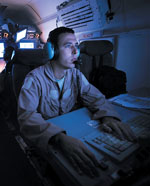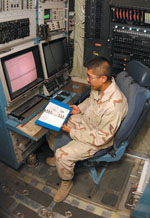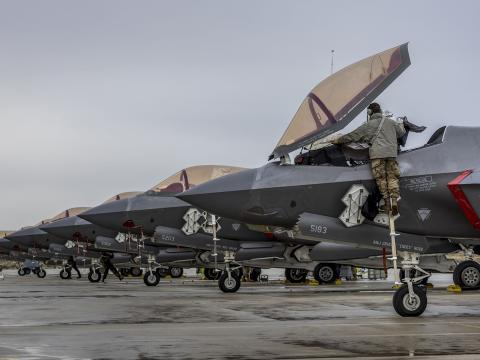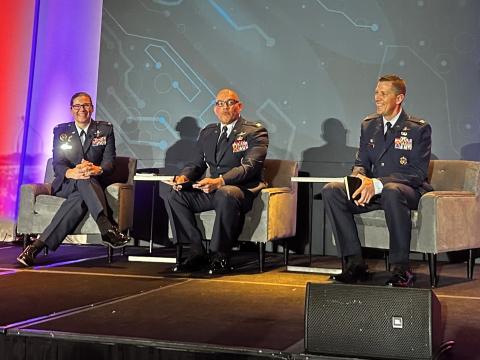Air Force Morphs Command And Control
A U.S. Air Force Joint Surveillance Target Attack Radar System (Joint STARS) air weapons officer tracks potential targets during a mission over Iraq. The E-8 Joint STARS aircraft is undergoing a modernization that affects an even larger overhaul of
Aging equipment and sustainability issues vie with resource limitations and new missions.
Air Force command and control.
Fighting in
Last year, the Air Force Air Combat Command (ACC) chartered a C2 tiger team to perform a complete review of all of the elements of the Air Force Theater Air Control System, or TACS. These include the E-3 airborne warning and control system (AWACS), the E-8 Joint Surveillance Target Attack Radar System (Joint STARS), elements of tactical air control parties, any field air support operations center (ASOC), and radars for control and reporting centers. The ACC faced challenges throughout TACS, including both geographical and functional air operations centers (AOCs).
“We have a changing mission set across the U.S. Air Force, with the renewed focus on irregular warfare and continuing operations in
“Ensuring that we have a vibrant, sustainable, responsive command and control has become a high priority for the Air Force,” Gen. Matthews declares. “It is important that we keep all the elements—the eyes and ears of the air control systems as well as the means to effect command and control—congruent and in lockstep with each other as we continue to modernize our forces.”
Gen. Matthews explains that the tiger team has four primary focus areas that also are interdependent. One involves a different way of looking at the C2 system from a component level. The general does not subscribe to the tenet of the AOC serving as a weapon system. Instead, he prefers to view the component-numbered air force—CNAF—as a weapon system. CNAF features a melding of a component commander’s staff along with its C2 element as a unified entity serving the commander’s responsibilities. It is a different way of structuring that takes into account the diverse priorities and challenges within each CNAF, he adds. AOC footprints might vary greatly among different CNAFs.
A second focus area is to determine how to move AOCs to a service-oriented architecture (SOA). The Air Force must move away from “proprietary, tightly coupled software suites that are difficult and costly to upgrade and update,” the general declares. As with the entire Defense Department software enterprise, the Air Force must examine different models for acquisition and sustainment. Moving to a SOA will enable better flexibility and adaptability for reacting to the evolving battlespace, he says.
The third focus area aims at reducing infrastructure and sustainment costs for information technology. Developing an operations support facility has been challenging for several reasons, the general notes, but consolidating servers and software could provide significant savings in operations sustainment costs.
This consolidation would need to be balanced against risk, he concedes. Consolidation always presents adversaries with tempting targets, but Air Force officials believe that consolidation can be achieved with the requisite security and reliability for supporting both peacetime and wartime C2 operations. Gen. Matthews offers that some experimental operating concepts and activities could be consolidated as an operations support facility in exercises this summer.
The fourth focus area is the recapitalization of the TACS. This comprises the full array of assets and related systems, many of which are showing their age in both capability and sustainability.
A U.S. Air Force staff sergeant prepares to engage in tactical command, control and communications countermeasures in an EC-130H Compass Call aircraft operating in Afghanistan. Operations in Southwest Asia are changing the Air Force’s information architecture as the service restructures its command and control.
The new TACS will feature a tighter integration of airmen with the system at a more decentralized level. The Air Force is seeking tighter integration at the ASOC division level. The ACC has conducted initial experiments with the joint air-ground integration cell (JAGIC), and these experiments will continue throughout the year. “We’re going to bolster our presence with the land component—at least initially at the division level, and potentially at the brigade and battalion levels,” Gen. Matthews warrants. He adds that the intent is to have tighter integration with the land component as decentralized planning continues to increase. 
This decentralized planning, which is characteristic of irregular warfare, does not run counter to Air Force centralized planning/execution tenets, the general emphasizes. Instead, the benefit is a better use of airpower and “bigger bang for our buck” when the Air Force has a stronger presence while the actual planning is occurring within the land component.
The JAGIC is one step in the integration process, but the Air Force also is striving for enhanced digital capabilities. Among the sought-after capabilities are direct information feeds to aircraft and a faster, more reliable way of passing information to troops on the ground. Gen. Matthews also lists development of an ASOC gateway and improved communication suite as other key ongoing efforts.
Modernizing C2 gear requires Internet protocol (IP) equipment that has a high turnover rate, which is a challenge given the number of AOCs the Air Force has around the globe. Software upgrades in the Theater Battle Management Core Systems (TBMCS) represent a considerable effort, especially in keeping these upgrades consistent across all of the AOCs, Gen. Matthews offers.
“The realities of ongoing combat operations in
Crewing AOCs also is daunting. The Air Force has had difficulty obtaining the requisite skill sets and numbers of people, Gen. Matthews relates, and it still lacks the full number that it envisioned in its original template for processes, software and hardware. Along with the other changes and challenges the Air Force faces, this places a significant manpower demand on C2. Accordingly, the Air Force must consider a different model for its C2.
Some of the challenges and tasks facing Air Force C2 can be found in the E-8 Joint STARS. The aircraft is undergoing a review of its sensor suite and capabilities, and this aims at determining how the mission set may have changed—and if those changes are enduring. Along with a re-engining effort, the aircraft’s integrated avionics suite is being assessed for long-term viability. Its APY-7 radar may be upgraded or replaced, as might its C2 suite for battle managers. “We have to make sure—based on how we now project the future security environment evolving—that we’re putting the right capabilities into this aircraft to support the joint warfight,” the general declares.
The same approach holds for ground elements such as the control reporting centers. The
For ground TACS elements, the Air Force needs “lighter, leaner and more robust communications” gear. This is especially vital as the service increases its integration with the land component, the general explains.
The Air Force is “facing issues with the continued sustainment” of its AN/TPS-75 ground-based radar system, Gen. Matthews says. The service is seeking a follow-on system that would be more reliable and capable. Radar systems in general will continue to migrate to electronically scanned arrays. They will vary in size, power and capabilities across various platforms ranging from unmanned aircraft systems (UASs) to wide-body aircraft.
The service also is deploying the new MC-12W intelligence, surveillance and reconnaissance (ISR) aircraft. The aircraft will provide a better-crewed ISR platform to support warfighters in
The E-3 AWACS is undergoing its Block 40/45 upgrade, and planners still are considering how many capabilities will be embodied within this upgrade. Gen. Matthews relates that the Air Force is “taking a hard look” at Ground Moving Target Indicator (GMTI) requirements, especially for UAS platforms.
Web Resource
Air Combat Command: www.acc.af.mil



